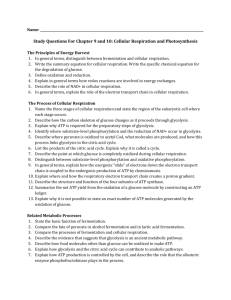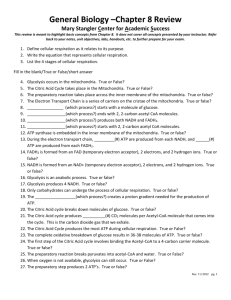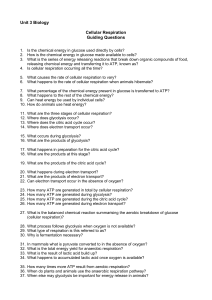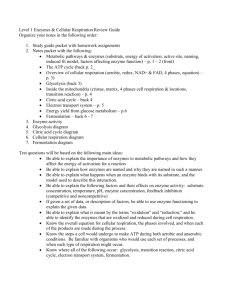Chapter 9 Cellular Respiration: Harvesting Chemical Energy
advertisement
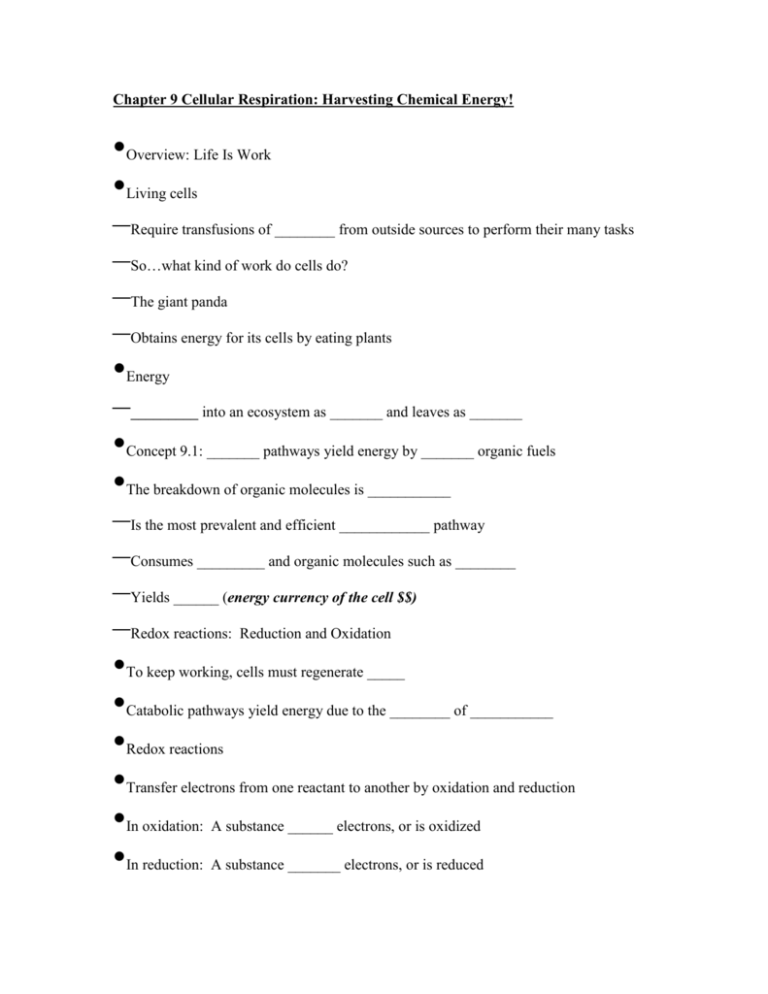
Chapter 9 Cellular Respiration: Harvesting Chemical Energy! • • Overview: Life Is Work Living cells –Require transfusions of ________ from outside sources to perform their many tasks –So…what kind of work do cells do? –The giant panda –Obtains energy for its cells by eating plants • Energy –_________ into an ecosystem as _______ and leaves as _______ • • Concept 9.1: _______ pathways yield energy by _______ organic fuels The breakdown of organic molecules is ___________ –Is the most prevalent and efficient ____________ pathway –Consumes _________ and organic molecules such as ________ –Yields ______ (energy currency of the cell $$) –Redox reactions: Reduction and Oxidation • • • • • • To keep working, cells must regenerate _____ Catabolic pathways yield energy due to the ________ of ___________ Redox reactions Transfer electrons from one reactant to another by oxidation and reduction In oxidation: A substance ______ electrons, or is oxidized In reduction: A substance _______ electrons, or is reduced • During cellular respiration – Glucose is oxidized and oxygen is reduced (write the equation noting what gets oxidized and what gets reduced) • • Cellular respiration ____________ glucose in a series of steps Electrons from organic compounds –Are usually first transferred to _________, a coenzyme • _____, the reduced form of NAD+ (a derivative of Niacin) • If electron transfer is not stepwise • The electron transport chain NAD+ is a what? –Passes the electrons to the electron transport chain –A large ________ of energy occurs –As in the reaction of _______ and ________ to form water –Passes electrons in a series of ______ instead of in one explosive reaction – Uses the energy from the electron transfer to form ______ Write one sentence explaining the purpose of the ETC. • • • • Respiration is a cumulative function of three metabolic stages 1. ________ 2. The citric acid _____ 3. Oxidative ____________ • Glycolysis • The citric acid cycle • ________ phosphorylation –Breaks down ______ (#) into two molecules of ___________ –Completes the breakdown of glucose –Is driven by the electron transport chain –Generates _______ of the ATP (it’s pretty important!) –An overview of cellular respiration (draw arrows below where ncessary ) Glycolysis (occurs in _________) • • • • Citric Acid Cycle Oxidative Phosphorylation (occurs in___________) Both glycolysis and the citric acid cycle can generate ATP by ________ ________ _________ Concept 9.2: Glycolysis harvests energy by oxidizing glucose to ______ Glycolysis means “splitting of ________”, breaks down glucose into __________ and occurs in the _________ of the cell. Glycolysis consists of two major phases 1. Energy __________ phase 2. Energy __________ phase The energy investment phase: The 6 carbon sugar has the addition of 2 phosphates- thus _______ 2 ATPs. This allows the formation of two 3-carbon sugars using a series of steps and specialized enzymes. The energy payoff phase: Produces ____(#) _____ and ______(#) ________. After a series of steps and enzymes reconfiguring the sugars, the final product is ___________. • • • Concept 9.3: The ____________ cycle completes the energy-yielding oxidation of organic molecules The citric acid cycle takes place in the _____________ of the mitochondrion. Before the citric acid cycle can begin –________ must first be converted to __________, which links the cycle to glycolysis –Write a sentence describing the purpose of gylcolysis. –An overview of the citric acid cycle (What is happening?) –A closer look at the citric acid cycle –What does it start with? _______________ What does it end with? _____________ • • • In the electron transport chain • At the end of the chain • ATP __________ • At certain steps along the electron transport chain Concept 9.4: During oxidative phosphorylation, ____________ couples electron transport to ATP synthesis. NADH and FADH2 donate electrons to the electron transport chain, which powers ATP _____________ via oxidative phosphorylation –Electrons from _________ and ___________ lose energy in several steps. –Electrons are passed to ________, forming water –Is the enzyme that actually makes ATP (Where is it located?) – Electron transfer causes protein complexes to pump ______ from the mitochondrial ___________ to the _________________ space. • • • • • The resulting H+ _________ 1. Stores energy 2. Drives chemiosmosis in ATP synthase 3. Is referred to as a ______________ force. What do you think this means? Chemiosmosis – Is an energy-coupling mechanism that uses energy in the form of a ______________ across a membrane to drive cellular work –Chemiosmosis and the electron transport chain (Where does this occur?___________) –During respiration, most energy flows in this sequence – Glucose to ________ to electron transport chain to ________________________ to ATP (add arrows below) – Energy flow = Glucose Electron transport chain ATP –There are three main processes in this metabolic enterprise – About __________ of the energy in a glucose molecule is transferred to ATP during cellular respiration, making approximately ______(#) ATP – Concept 9.5: ___________ enables some cells to produce ATP without the use of ______ –Cellular respiration –Relies on _______ to produce ATP –In the absence of oxygen –Cells can still produce ATP through _________ –Is a partial degradation of sugars that occurs without oxygen –__________ –Can produce ATP with or without oxygen, in aerobic or ___________ conditions –Couples with fermentation to produce ATP –Fermentation consists of… –Glycolysis plus reactions that regenerate _______, which can be reused by glycolysis –NAD is the electron ________ and acts as the _________ agent + –In _______ fermentation, pyruvate is converted to _________ in two steps, one of which releases _______. – During ______________ fermentation, pyruvate is reduced directly to _______ to form lactate as a waste product –Both fermentation and cellular respiration – Use __________ to oxidize glucose and other organic fuels to pyruvate (in the __________) –Fermentation and cellular respiration –Differ in their final ________ acceptor –Cellular respiration –Produces more ATP –__________ is a key juncture in catabolism –Glycolysis –Occurs in nearly all organisms – Probably evolved in ancient _____________ before there was _________ in the atmosphere – Concept 9.6: Glycolysis and the citric acid cycle connect to many other _________ pathways –__________ pathways –Funnel electrons from many kinds of organic molecules into cellular respiration –The catabolism of various molecules from food –The body –Uses small molecules to build other substances –These small molecules –May come directly from food or through glycolysis or the citric acid cycle –Cellular respiration – Is controlled by __________ enzymes at key points in glycolysis and the citric acid cycle –The control of cellular respiration – –





